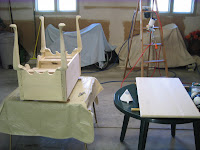Sunday, November 27, 2011
Poplar Lowboy - Cherry Finish Part -2-
Posted by Ace Holeinone at 12:07 PM 0 comments
Monday, November 21, 2011
Poplar Lowboy - Cherry Finish Part -1-
The Test Board...you do those, don't you??????
- Sand the poplar to 180
- Wash-coat is a General Finishes (water-based) High Performance Topcoat mixed in equal parts with water
- Dye is General Finishes (water-based) Cinnamon
- Topcoat is General Finishes High Performance
- Stain is General Finishes (water-based) Black Cherry

The left board in the picture above, is entirely of poplar heartwood. I followed the above procedure sealing the dye over with topcoat. So here is the thing, since the heartwood board will tone or stain darker, due to the fact, poplar heart is darker than the whitish sapwood. The heart wood board will shade about 1 coat darker. So to even out, I had to apply a second coat of stain to the sapwood board.
Posted by Ace Holeinone at 4:54 PM 1 comments
Thursday, November 17, 2011
General Finishes - Crosslinker Additive - Not In Retail Stores
 Word on the street is... General Finishes will no-longer sell their additive product called Crosslinker to the retail market. However, still available to the "professional" line of products in quart containers to mostly use in conjunction with General Finishes 450 product line. General Finishes have fortified their products and product lines making crosslinker mostly obsolete.
Word on the street is... General Finishes will no-longer sell their additive product called Crosslinker to the retail market. However, still available to the "professional" line of products in quart containers to mostly use in conjunction with General Finishes 450 product line. General Finishes have fortified their products and product lines making crosslinker mostly obsolete.
Crosslinker is an additive product which was sold separately to enrich certain General Finishes products, making then more durable and chemical resistant.
Posted by Ace Holeinone at 11:13 AM 0 comments
Saturday, November 12, 2011
Used LVLP Tool Score - Iwata LPH400-134LV Spray Gun
Posted by Ace Holeinone at 2:49 PM 0 comments









